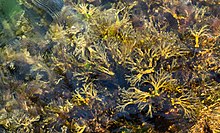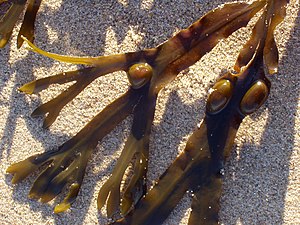Fucus vesiculosus
| Fucus vesiculosus | |
|---|---|

| |
| Scientific classification | |
| Domain: | Eukaryota |
| Clade: | Diaphoretickes |
| Clade: | SAR |
| Clade: | Stramenopiles |
| Phylum: | Gyrista |
| Subphylum: | Ochrophytina |
| Class: | Phaeophyceae |
| Order: | Fucales |
| Family: | Fucaceae |
| Genus: | Fucus |
| Species: | F. vesiculosus
|
| Binomial name | |
| Fucus vesiculosus | |

Fucus vesiculosus, known by the common names bladderwrack, black tang, rockweed, sea grapes, bladder fucus, sea oak, cut weed, dyers fucus, red fucus and rock wrack, is a
Description
The fronds of F. vesiculosus grow to 150 cm (59 in) long and 2.5 cm (1.0 in) wide and have a prominent midrib throughout. It is attached by a basal disc-shaped holdfast. It has almost spherical air bladders, which are usually paired one on either side of the mid-rib but may be absent in young plants. The margin is smooth and the frond is dichotomously branched. It is sometimes confused with Fucus spiralis with which it hybridises and is similar to Fucus serratus.[2][3]
Distribution
Fucus vesiculosus is a common large alga on the shores of the British Isles.[4] It has been recorded from the Atlantic shores of Europe, Northern Russia, the Baltic Sea, Greenland, Azores, Canary Islands, Morocco and Madeira.[5][6] It is also found on the Atlantic coast of North America from Ellesmere Island, Hudson Bay to North Carolina.[7]
Ecology
The species is especially common on sheltered shores from the middle
Biology
Plants of F. vesiculosus are
Individuals of F. vesiculosus from the North Sea colonized the Baltic Sea less than 8,000 years ago. The event is paralleled by a switch from what seems to be obligate sexual recruitment to facultative asexual recruitment.[14] Asexual reproduction in Baltic Sea populations is accomplished by the production of adventitious branches that come loose and reattach to the bottom by the formation of rhizoids. Adventitious branches are present in thalli of F. vesiculosus in other areas too but asexual formation of new thalli has never been reported outside the Baltic Sea.[14][15]
Consumption
Fucus vesiculosus is sold as a nutritional supplement. Primary chemical constituents include
Adverse effects
Consumption of F. vesiculosus can cause
Some people may suffer an
See also
References
- ^ "Bladderwrack". WebMD. Retrieved 27 September 2018.
- ^ a b c d Nicola White (2008). "Bladder wrack – Fucus vesiculosus". Marine Life Information Network. Archived from the original on 2012-04-02. Retrieved December 13, 2013.
- ^ Newton, L. 1931. A Handbook of British Seaweeds. London. British Museum (Natural History)
- ISBN 978-0-9527115-1-3. Archived from the original(PDF) on 2014-02-01. Retrieved 2014-01-18.
- National University of Ireland, Galway. Retrieved April 22, 2012.
- .
- ^ ISBN 978-0-472-04904-2.
- ISBN 978-0-521-40897-4.
- S2CID 21550668.
- S2CID 5821145.
- S2CID 84362547.
- PMID 19954804.
- PMID 11607682.
- ^ S2CID 16619196.
- PMID 27525655.
- ^ a b "Herbs to Avoid Before Surgery". University of Texas, El Paso.
- ^ "Bladderwrack". MedlinePlus. National Institutes of Health. Retrieved December 13, 2013.
External links
 Media related to Fucus vesiculosus at Wikimedia Commons
Media related to Fucus vesiculosus at Wikimedia Commons- Bunker, F. "Fucus vesiculosus Linnaeus Le Jolis". British Isles Seaweed Images. Archived from the original on 2012-03-24. Retrieved 2007-05-14.
- Guiry, M. D. "Fucus vesiculosus Linnaeus". North Atlantic Seaweeds. Archived from the original on 2010-10-07. Retrieved 2010-05-04.
- "Bladder wrack (Fucus vesiculosus)". ARKive. Archived from the original on 2011-08-23. Retrieved 2011-05-20.
- "Bladder wrack (Fucus vesiculosus)". Marine Life Information Network (MarLIN). Marine Biological Association of the UK. 2008.
- Guiry, M.D. (2017). Guiry, M.D.; Guiry, G.M. (eds.). "Fucus vesiculosus Linnaeus". AlgaeBase. Galway: National University of Ireland.
- Photos of Fucus vesiculosus on Sealife Collection
